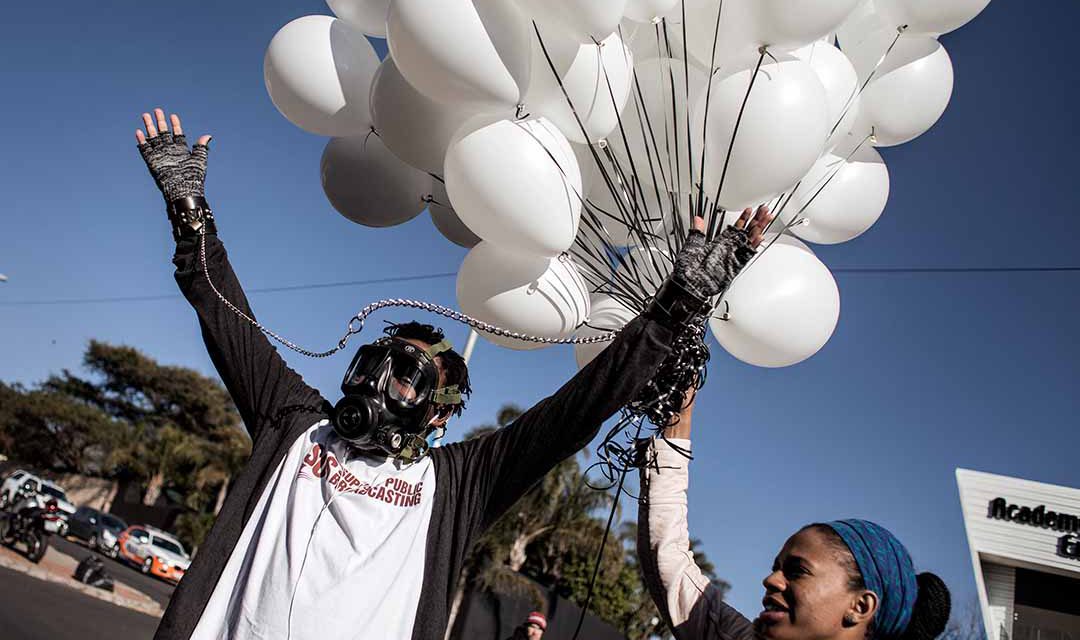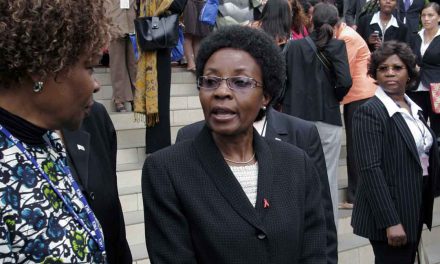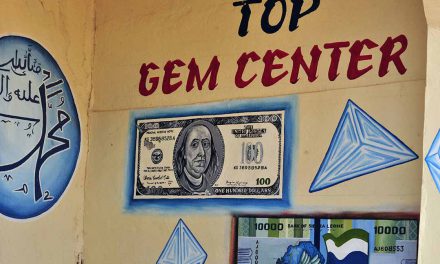Press freedom: the fiercest battle
How South African private media played a pivotal role in mobilising civil society to expose a corrupt president and his cronies

A protester wearing chains and a gas mask rallies outside the SABC to protest alleged bias and censorship before key municipal elections, 2016 Photo: John Wessels / AFP
What is it to be an “African journalist”? Working in African countries can mean operating in challenging conditions, with limited resources and sometimes restrictive political environments. African media have been shaped by their histories – as colonial, revolutionary or post-independence presses, as state broadcasters, as community or development projects. To make this possible in South Africa, for example, public institutions were captured through aggressive “cadre deployment” practices, a policy of the ruling African National Congress (ANC) that has seen many key technocratic and managerial positions in the civil service and the state-owned enterprises going to political cronies within the ruling party, and which has reportedly helped to render key law-enforcement agencies impotent. Although they might have pursued their personal interests with the straightforwardness of a medieval court, Zuma and his cronies understood the importance of information in a modern democracy. Control over mass media was central in their quest for unchecked power.
With the ANC in charge of virtually all the relevant governing bodies, elections were the biggest threat to their hegemony, both in the national institutions and within the ruling party. It must therefore have seemed of capital importance to the Zuma faction within the ANC to keep the masses oblivious to their corrupt practices. The most obvious vehicle for any government to achieve this would be the public broadcaster, which is is often under (in)direct state control and which usually enjoys a large audience in the population. The latter is particularly true in South Africa, a highly unequal society where millions have no access to the internet or other sources of information, and instead have to rely on the South African Broadcasting Corporation (SABC). Some form of political control over public broadcasters is not a serious issue in countries where the relative independence and stability of other institutions, including media authorities and privately-owned media operations, helps to prevent party-political or partisan broadcasting.
But it is probably true to say that the SABC, which was started by the apartheid regime, has never been an example of independence from government interference. “In South Africa, 22 million people have the SABC as their only source of news,” veteran radio journalist Foeta Krige told Africa in Fact. “If a political party can control the SABC, they control what’s going out to a huge part of the electorate.” And it was here that one of the fiercest battles for media freedom of that period happened. It was fought by the SABC 8, a group of journalists who in May 2016 refused to follow orders to leave violent anti-government protests out of the daily news bulletins. Krige was one of them. As punishment for standing up to Zuma’s enforcers, the SABC 8 were fired and threatened for months by faceless thugs who echoed the government’s discourse on critics. As part of this, they claimed that SABC 8 whites were agents of imperialism and that their black and Indian colleagues were useful idiots or despicable déclassé sell-outs.
Through the justice system and the processes of public participation in parliament, and by mobilising public opinion, the SABC 8 eventually regained their jobs, got the censorship orders revoked and exposed the rot at the institution. Their actions initiated the fall of one of the most toxic characters of the Zuma cohort: former SABC boss and censor-in-chief Hlaudi Motsoeneng. But the group’s victory was achieved at great personal cost to the group. One of its members, Suna Venter, was threatened and spied on. Her apartment was broken into. The tyres of her car were slashed and the brake cables of the vehicle cut. She was shot at twice while driving. On one occasion, she was taken out of her bed at night, waking up hours later tied to a tree on a Johannesburg hilltop. She died in June 2017, reportedly as a result of the stress of the campaign of threats and violence against her. Zuma’s exploitation of the media was not limited to the public broadcaster. Using public money, his administration facilitated the launch of The New Age newspaper and news channel ANN7, two private outlets that aimed to feed their audiences with pro-government propaganda.
This also benefitted their owners – the infamous Gupta brothers who massively enriched themselves and some Zuma family members at the expense of the South African taxpayer (see Italics below). More subtle were the Zuma government’s manoeuvres to manipulate journalists into helping to discredit honest officials who refused to be intimidated or bought off. In 2014, journalists at the Sunday Times were fed false information about a unit within the South African Revenue Service (SARS) that was supposedly operating outside the law. This narrative, which was apparently initiated within the Zuma camp, was legitimised and propelled by the Sunday Times in several front-page stories. It discredited some of the country’s most capable public servants and permitted the government to act against a legitimate anti-tax evasion unit that threatened illicit businesses belonging to the president’s cronies. The information was subsequently revealed to have been a hoax and the “rogue unit” saga succeeded in casting doubts on the credibility of investigative media.
The costs of the Zuma years
State capture has seen South Africa subjected to gigantic costs to the national economy and the country’s reputation. No final figure is available, and perhaps never will be, of the direct economic costs, but some of the indications are telling. The phenomenon of state capture began with former President Thabo Mbeki’s administration in the mid-1990s, when it was introduced as the ANC’s official policy of “cadre deployment”, or the placing of politically connected individuals in key posts. Over time, the approach came to be associated with, and then rebranded as “radical economic transformation” by Jacob Zuma’s supporters within the ruling party. Zuma’s first term as president began in 2008, and his presidency was terminated at the end of 2017, when he narrowly lost a leadership contest within the ANC to current incumbent Cyril Ramaphosa.
In 2007, the year before Zuma took power, the country had a R9.5 billion surplus; in last year’s budget, the country had a debt of R246 billion, according to a March 2019 report by South African news outlet biznews.com. In December 2015, after Zuma suddenly fired finance minister Nhlanhla Nene some R378 billion was wiped off Johannesburg Stock Exchange shares, taking with it some 148,000 jobs. In March 2017, South African bonds and listed companies lost R506 billion when Zuma summarily fired two other finance ministers, Pravin Gordhan and Mcebisi Jonas, according to the same report. Between 2012 and 2017, foreign direct investment in the country declined by 41%, from $4.5 billion to $1.3 billion. Investors were reluctant to commit to the country because of an “underperforming commodity sector and political uncertainty”, according to the World Investment Report 2018.
According to an October 2018 report by Bureau of Economic Research, South Africa’s GDP in that year had declined by between 10 and 30% below projections since 2008, and some 500,000 to 2.5 million jobs had not been created. Meanwhile, state-owned enterprises have been struggling to survive in the post-Zuma years. The national power utility, Eskom, declared the world’s best power utility in 2003, currently has a debt of an estimated R500 billion – a figure so large that commentators, including members of the government, say it may threaten the economy. The national airline is in business rescue after decades of government bailouts, while Denel, an arms manufacturer, and Prasa, the national railroad agency are in fiscal intensive care. The Zondo Commission, on state capture, which began its work in August 2018, has yet to conclude. In July last year, Gordhan, since appointed public enterprises minister, revealed that some 3,000 forensic reports had been compiled on the SOEs since 2017 when the indications of the true extent of state capture first emerged.
Zuma’s association with the Guptas appears to have allowed the Indian-born businessmen influence over government policy and appointments, and given them access to large, corruption-driven lucrative government tenders. Gordhan is reported to have said that the Guptas may have succeeded in stealing as much as R50 billion from the state. They have fled the country, with reports suggesting that they are in Dubai, with which the South African state is reported to be negotiating an extradition treaty. Zuma denies any responsibility for the actions of the Guptas, although he has also defended them as “friends”, or for the dramatic decline in the country’s economy under his watch, accusing critics of mounting a political campaign against him. Meanwhile, calculating the direct costs of Zuma’ presidency to the country can be difficult, given that such budget items are often well hidden in government accounts.
However, according to a 2012 report by Gareth van Onselen on Politicsweb, a South African news outlet, in 2012 Zuma’s presidency – including his salary, accommodation, support for his wives and the costs of an army medical unit in permanent attendance – were about R1.5 billion annually. That figure, which van Onselen regarded as conservative, was equivalent to about 31,275 jobs, calculated at the national average salary of that year of R47,964, according to figures by the School of Economic and Business Sciences at the University of the Witwatersrand.
Several testimonies point to the hand of the secret services behind the scheme to discredit the SARS unit. Although they have no definitive proof, Krige and his SABC 8 colleagues suspect state intelligence was also behind the anonymous threats and attacks on them. The use of the security agencies to interfere with the media is not new in post-apartheid South Africa. One of its finest investigative journalists, amaBhungane’s Sam Sole, was told in 2009 “by people from within the intelligence community” that the secret service was recording his phone calls. “We laid a complaint with the Inspector General of Intelligence, but they took a couple of years to get back to us,” Sole tells Africa in Fact. “They didn’t even say if we were monitored or not. All they said was: ‘we did an investigation and nothing illegal was done’.” The evidence he was looking for emerged in 2015, when Zuma filed court papers to oppose the official opposition’s bid to have criminal charges against him reinstated in a matter relating to the 1990s arms scandal, during which Zuma was reported to have been paid by a foreign arms company to represent its interests.
Attached to his lawyer’s affidavit were transcripts of conversations Sole had with a senior prosecutor while the journalist was working on an investigation. Zuma’s team said the evidence showed that the senior prosecutor’s conversation with Sole supported their claim that the charges against the applicant had been orchestrated by his political rivals. “We used that to launch a challenge to the surveillance legislation [under which he was spied on],” Sole recalls. On 16 September, 2019 a ruling of the High Court in Johannesburg declared sections of the Regulation of Interception of Communications and Provision of Communication Related Information Act (Rica) unconstitutional, arguing that it gave excessive powers to spymasters to the detriment of citizens’ privacy, as well as compromising the right of journalists to keep their sources confidential. However, Sole’s experience of being bugged contributed to the success of one of the greatest feats in the history of South African journalism. In early 2017, anonymous whistle-blowers sent South African online publication Daily Maverick what appeared to be a trove of e-mails and documents from the command centre of the Gupta business empire.
“When we handled the Guptaleaks we were extremely careful not to let anybody know what we had, and what we were doing,” Sole recounts. Instead of securing a huge scoop by keeping the information for his paper, Daily Maverick’s editor-in-chief Branko Brkic “immediately” contacted his colleagues at amaBunghane to seek assistance. He had previously worked with them and knew about their “expertise” in investigating corruption in general and the Gupta’s dirty businesses in particular. “I’d have betrayed South Africa’s future if I’d seen it as an opportunity for myself,” Brkic told Africa in Fact. Sole praises Brkic’s “very mature and responsible” decision to invite them to work together when the Daily Maverick realised “they didn’t have the capacity to deal with something this big on their own”. Brkic deems the work that followed “a testimony of a collaboration well done”. As South Africans would find out later, the impressive cache of secrets Daily Maverick received revealed the extent of the Gupta family’s influence over the government and how they were using it to obtain contracts with state companies.
Conscious of how damaging the information was for some of the most powerful people in the country, Brkic, Sole, his fellow amaBhungane journalist Stefaans Brummer and the small group of people who had access to the files only discussed the matter face to face and worked on computers not connected to the internet. “If they had prior knowledge, we would have been vulnerable to search and seizure and so on,” Sole points out. “So that experience with surveillance was important in making us very careful.” By being “very careful” Sole and his colleagues were also protecting the whistle-blowers. The Daily Maverick and amaBhungane only started publishing the so-called Guptaleaks months after they received the material. “It took us quite a while to get going, because we first had to essentially raise money to take the whistle-blowers to safety,” Sole says about the “discreet” process involving several sectors of society that made their relocation abroad possible. With South African state institutions such as the National Prosecution Authority (NPA), the Hawks, an elite investigation unit, and parliament under Zuma’s iron grip, it was the private media that took on the task of keeping those in power accountable.
The Guptaleaks and other media investigations played a vital role in fostering the civic mobilisation against Zuma that forced many, even within the ANC, to speak out against the president’s abuses. This process eventually led to the ANC recalling Zuma before the end of his term following his camp’s defeat at the party’s elective conference. It might be said that independent journalism has not influenced the political course of other African countries on the scale it has done in South Africa in recent times. Apart from a better-established private media and a stronger civil society, South African journalists had in their favour an independent judiciary capable of ruling against the government. The substantial impact journalistic investigations had in putting an end to Zuma’s corrupt administration owed a great deal to the culture of dissent within the ANC, whose way of electing its leaders ultimately prevented the institution of a potentially autocratic Zuma dynasty in power. “In other countries the presidency would have had a much more handson control over other institutions,” notes Daily Maverick’s Brkic. Indeed, in African countries where authoritarianism holds sway, journalists have been convicted and jailed by subservient judges.
In Angola, for instance, investigative journalist Rafael Marques de Morais was handed a six-month suspended jail sentence in 2015 for criticising politicians who supported the regime. De Morais’s persecution was pugnaciously contested by the country’s thriving civil society. Yet despite the magnitude of the scandal he revealed, then-President Eduardo dos Santos remained the unchallenged leader of the ruling MPLA until he stepped down when he chose to retire in 2017, after 38 years in power. Similar situations have been reported in recent years in countries such as Zimbabwe and Cameroon, where journalists have been threatened, attacked, arrested and charged for criticising their authoritarian governments or informing about their abuses. Sadly, such events are emblematic of the state of things in many African countries. In the absence of effective mechanisms to enforce democratic laws and processes, politics is often determined by force, and governments are able the abuse state security structures and resources with impunity.
But as Ntibinyane Ntibinyane, co-founder of Botwana’s INK Center for Investigative Journalism, pointed out in a 2018 article, examples of valuable investigative work are abundant in the rest of Africa, with new media outlets, often constituted as non-profit organisations and funded by individual and international donors, increasingly setting the agenda. In 2018 alone the Global Investigative Journalism Network identified 10 outstanding investigative stories produced by African journalists – including revelations of human rights abuses, corruption, information data breaches, sexual violence and gross state negligence in Ghana, Zimbabwe, Uganda, Malawi, Cameroon and Kenya among other countries.
Marcel Gascón Barberá is a freelance journalist. He lives in Johannesburg and writes for several Spanish and international publications. He has previously worked as a correspondent for EFE Spanish News Agency in Romania, South Africa and Venezuela.












